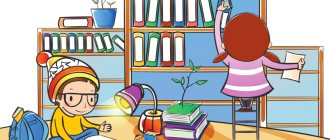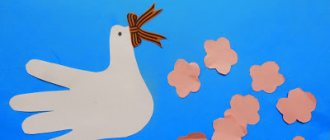Thematic planning for design in the preparatory group
Olga Khlebnikova
Thematic planning for design in the preparatory group
Thematic planning for design in the preparatory group
Lesson 1
Kindergarten building ( constructor )
Goal: To teach children to create a building that meets certain requirements. To form generalized ideas and knowledge in children. Strengthen the ability to make floors. Develop the ability to work together without interfering with each other. Learn to maintain correct posture during class.
Lesson 2
“Multi-storey house”
(from paper)
Purpose: to learn how to make a pattern and sequentially paste boxes with colored paper, complement the craft with applique images of windows, create a collective building, cultivate love for family, home, hometown, develop imagination
Lesson 3
Road signs (fabric)
Goal: Continue to develop knowledge about road signs. Develop the ability to match colors to familiar traffic signs. Continue learning how to work with fabric.
Lesson 4
Topic : Cozy room (collective, matchboxes)
Goal: continue to teach children to work in a team. divide the production of furniture between two children. learn to make patterns from paper, decorate with fabric and appliqué in the form of geometric shapes and flowers. Use technical material.
Lesson 5
Cookies – a cereal product (made from dough)
Goal: To teach children to think about the content of their work based on personal experience. Clarify and consolidate children's knowledge about bakery products. To develop the ability to convey the shape of familiar objects and their proportions.
Lesson 6
Beautiful bouquet (Ikebana)
Goal: to introduce children to the concept of ikebana composition, the birthplace of which is Japan. Explain how to properly arrange flowers and plants in a vase or other stand. Teach children how to prepare material for ikebana.
Lesson 7
Funny still life (made of fabric)
Goal: to develop children’s imagination, interest in the environment, consolidate knowledge about still life, and the ability to correctly arrange objects compositionally; consolidate skills in working with templates, fabric, scissors.
Lesson 8
Fly agaric (origami)
Goal: to develop the ability to fold a sheet of paper in different directions, to develop the eye, to accustom one to precise finger movements under the control of consciousness. Cultivate neatness.
Lesson 9
Table and chair
Goal: Continue to teach children how to build various pieces of furniture (table and chair)
according to the drawing, unite the buildings with a single plot, and play with them together.
Strengthen the ability to reflect existing ideas from your experience
designs Develop ideas about construction details. Educate to strive to help each other. Lesson 10
Village shred (fabric)
Goal: to create an image of a fairy-tale village from flower scraps; continue to teach children to perform teamwork and develop the ability to negotiate during joint activities.
Lesson 11
Hedgehog thorn (origami)
Goal: continue to teach children to fold a sheet of paper in different directions; develop eye and motor skills. Instill a love for the animal world.
Lesson 12
"Swan"
.
Goals: develop creativity, fine motor skills, attention, speech; enrich vocabulary; develop accuracy and patience; continue to teach different techniques for working with natural materials, plasticine; cultivate friendly relations in the team, goodwill, mutual assistance; instill love for the world around us.
Lesson 13
"Train Station"
Goal: To train children in constructing familiar buildings from memory, encouraging them to show creativity and ingenuity, and teach them to negotiate the upcoming work. Develop children's creative abilities. Develop the ability to evaluate the work of comrades.
Lesson 14
horse
Goal: to make a three-dimensional composition from rectangular matchboxes, to develop imaginative thinking, fine motor skills, careful use of scissors, to complement the elements of the composition using colored paper: eyes, tail, mane. Reinforce knowledge about pets.
Lesson 15
By design
Goal: To teach children to decide together what they will design . Develop in children a desire to experiment. To develop the ability to evaluate the work of comrades and make suggestions for improving the invention.
Lesson 16
Sled
Goal: to develop the ability to carefully cut out parts for crafts. Bend the surface of the strips, glue the finished parts onto a previously prepared surface , use waste material in the work.
Lesson 17
Christmas decoration
Goal: improve the ability to work with paper and threads; create a Christmas tree decoration from waste material; develop creative imagination and artistic taste; cultivate accuracy and emotional responsiveness.
Lesson 18
by design ( designer )
Goal: to consolidate acquired knowledge and constructive skills , the ability to create a plan and implement it.
Lesson 19
Elephant (origami)
Goal: to continue to develop the skill in children to independently read an origami diagram, fold a figure from two parts and small parts. Understand the concept from yourself, towards yourself, to bend it inward. carefully use glue when gluing parts, complement the parts with drawing.
Lesson 20
Passenger car
Goal: to clarify ideas about passenger transport, the variety of its types, the dependence of the design of each type of transport on its purpose. Develop the ability to create three-dimensional compositions from matchboxes. Learn to work according to plan, develop imagination, speech when explaining work.
Lesson 21
Sports school building.
Goal: To form generalized ideas about buildings in children. Strengthen the ability to design buildings that meet certain requirements, independently select the necessary building material. Teach children to make a more complex ceiling, build a fairly complex structure , and decorate the building.
Lesson 22
Arisha – fashionista (fabric)
Goal: to develop children's creativity, to form the concept of folk clothing, its elements, the ability to arrange costume elements in a certain sequence, taking into account their relationship with the image of the human figure, to develop fine motor skills of the hands, eye, analytical thinking, imagination, artistic taste, to cultivate accuracy.
Lesson 23
Rocket (paper)
Goal: to introduce children to the structural features of a rocket, its purpose, and to promote the development of skills and abilities to work with paper.
Lesson 24
cactus in a pot
Goal: To develop children's understanding of how plants adapt to the climatic conditions of their habitat. To develop children’s practical skills in creating a given image through plasticineography. Learn to use the possibilities of waste material to give the object completeness and expressiveness. Continue to introduce children to the properties of plasticine.
Lesson 25
Gitsiant (facing)
Goal: to develop interest in artistic creativity; learn how to create three-dimensional flowers from paper; develop aesthetic feelings and emotions; the desire to please your loved ones; cultivate independence, accuracy in work, love for loved ones.
Lesson 26
Let's glue our books
Goal: To develop a caring attitude towards books in children. Introduce children to book production. Strengthen labor skills in working with scissors and glue. Teach children to work individually and in a team. Organize your own cleaning of the workplace. Finish what you start.
Lesson 27
Microdistrict of the city
Goal: to teach children to create complex buildings, jointly plan the distribution of structures on the table plane , agree on who will do what part of the work, look for rational solutions, use their knowledge and design experience .
Lesson 28
Topic : “Painted tubs”
(made of paper)
Purpose: to develop children’s ability to make Russian folk souvenirs as a gift to a loved one. Supplement the souvenir with a wood pattern - buckets, draw a pattern on the rocker with a felt-tip pen. To foster patriotic feelings and accuracy when working with glue and scissors.
Lesson 29
Topic : Daddy octopus and octopuses (napkins)
Goal: to interest children in making a simple three-dimensional craft from crumpled paper and napkins of different colors. Use waste material for decoration. Develop imaginative thinking and the ability to work collectively.
Lesson 30
Topic : Robot's journey to planet Earth
Goal: to train children in modeling and designing from building materials and construction ; fix the name of the parts of the building material; develop attention, imagination, intelligence.
Lesson 31
Topic : Wonderful bird (origami)
Goal: to expand children's understanding of the art of origami paper folding. Strengthen bird folding skills (basic form - kite)
. cultivate artistic taste, the desire to please your loved ones or strangers.
Lesson 32
"Sewing Buttons"
Goal: To develop children’s ability to sew buttons with an eyelet; Continue to develop the ability to independently perform practical work; Develop eye, attention, fine motor skills of the fingers; Cultivate accuracy and a sense of responsibility for the quality of work performed.
Lesson 33
By design
Goal: Continue to teach children to independently choose a theme for construction. Develop the ability to select the necessary material, focusing on the plane. Strengthen the ability to consistently build structures , outlines of future buildings. Cultivate a desire to take care of your health.
Lesson 34
Greeting card for May 9th.
Goal: To strengthen children’s skills in working with paper and to develop the ability to compose a thematic composition . Foster a sense of respect for the older generation and love for the Motherland.
Lesson 35
Undersea world
Goal: To systematize children’s ideas and knowledge about the underwater world, the diversity of plants and inhabitants of the underwater world. plan the sequence of work and distribute its volume among the children of the whole group ); to train children to act differently with paper of different densities (crumple, tear, stick)
; learn to cut out shapes of sea creatures with scissors. to develop in children the skills of teamwork, the ability to coordinate their plans and distribute work.
Lesson 36
Spruce trees at the edge (origami)
Goal: to consolidate the ability to fold a square of paper along, across, diagonally, to smooth out folds well, to decorate with applique, to create an image of a spruce from several triangular blanks, to consolidate the ability to work collectively.
Lesson 37
Subject : Traffic light (from waste material)
Goal: to clarify ideas about traffic lights, the variety of its types, and the design dependencies of each type . Develop the ability to create three-dimensional compositions from matchboxes. Learn to work according to plan, develop imagination, speech when explaining work.
Summary of the lesson on designing “Round Dance of Friendship”
Municipal autonomous preschool educational institution
"Kindergarten No. 36 of a general developmental type."
Summary of the lesson on designing “Round Dance of Friendship”
in the preparatory group
Conducted by Pozdeeva L.V.
Tasks:
Continue to teach children how to design a toy based on a cone, independently cut out and connect the parts together in the specified sequence and according to the pattern. Practice making patterns from strips of paper of different colors, beautifully placing them on the details of clothing: the hem of the dress, the sleeves
· . Give children an idea of planet Earth; introduce dolls of different nationalities; teach the ability to work with paper and cardboard; consolidate skills in working with scissors and glue, form auditory attention, memory, thinking; the ability to reason and draw conclusions based on the information received.
· . To deepen children's understanding of kindness as a valuable, inherent quality of a person. Develop children's creative abilities and teamwork skills.
· Cultivate moral and emotional qualities: patience, attentiveness, sympathy, empathy, friendship.
Vocabulary work:
Round dance, friendship, harmony.
Preliminary work:
Examination of the globe, dolls of different nationalities, conversation about the native land, friendship of the peoples of the world.
Materials used:
Globe, dolls of different nationalities, cardboard, colored paper.
Methods:
Verbal, Visual and demonstration, Practical.
Integration of educational areas:
“Cognition”, “Communication”, “Work” “Music”.
National Unity Day. For this holiday, the teacher should invite students to make an applique of a round dance of children in costumes of the nationalities of Russia with the corresponding national symbols.
National Unity Day. For this holiday, the teacher should invite students to make an applique of a round dance of children in costumes of the nationalities of Russia with the corresponding national symbols
Progress of the lesson
Educator:
Hello guys. I invite you to my workshop, where we will make a round dance of friendship with dolls. And the magic rope will help us with this. But before we start work, we will talk with you. I ask you to sit down at the table.
Educator:
Children, what planet do you and I live on?
Children:
On the Earth.
Educator:
Right. Let's look at the diminutive model of our planet - the globe.
If we travel around the globe, we will meet people of different nationalities who have their own traditions, culture, and customs. But they differ not only in this, but also in appearance.
Look, this doll is from Japan. Japan is the land of the rising sun, which is located in the East of Russia. What country do you think this doll is from?
Children:
From Africa.
Educator:
Right. Africa is a whole continent where Arabs and blacks live.
And this doll is from Austria. Austria is located in the center of Europe.
This doll is from Portugal. Portugal is located in South-West Europe
Show of dolls.
Educator:
Look, they differ from each other in skin color, hair color, eye shape, national clothing. But all over the planet people dream of living in peace and friendship. Guys, let us do a “Round Dance of Friendship”.
Educator:
And for this we have cardboard and colored paper, we will make a cone from cardboard - this will be the basis for making a doll.
We coat the edges with glue and glue them together, cut out the head using a stencil, draw eyes, nose and mouth with a felt-tip pen, decorate the clothes with various patterns.
Children complete the task.
Educator:
Look what wonderful dolls we have made. They are different, like all people on the planet.
Educator
: Guys, did you enjoy traveling around the countries?
What object helped us with this? (Globe).
What nationalities of dolls did we meet?
Guys, let’s take our round dance of dolls and stand in a circle with them, and the song “Let the sun shine” will help us with this.
Let's hold hands and stand in a circle.
Every person is a friend to another.
Let's hold hands - let it pass
There is a huge round dance on Earth.
Children perform a song.
Educator:
Thank you guys for your round dance. I think that all the dolls will be happy with such a beautiful round dance.
The teacher offers samples of dolls for viewing.
—What are these dolls made of?
-What's on their head?
—What are the clothes decorated with?
Then the teacher shows and explains the sequence of making the doll:
1) Cutting out all the details (the teacher has them cut out in advance);
2) Partial demonstration of drawing a face and patterns on clothes with an explanation of how best to place patterns on parts of clothes;
3) Making tukhia: drawing an embroidery pattern and gluing foil circles - “coins”;
4) Gluing parts to obtain a doll.
Next, the teacher reminds you what Chuvash embroidery patterns can be used to decorate clothing details.
Children go to the tables and begin to work independently. The teacher provides assistance in choosing patterns for drawing embroidery, colors, and location of patterns on parts.
At the end of the lesson, children arrange a round dance of dolls, choose the doll they like, motivating their choice. You can invite children to talk about their doll.




